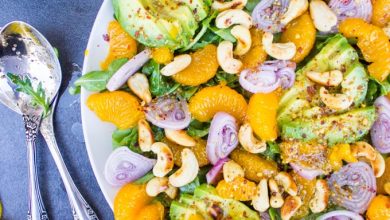🍽️ Antipasto Lasagna: A Delightful Fusion 🇮🇹
Antipasto lasagna is a creative fusion of Italian and American cuisines, combining the flavors of antipasto platters with the comforting layers of lasagna. This dish is a delightful twist on the classic Italian pasta, offering a unique blend of tastes and textures. Let’s dive into its history, components, preparation steps, and the time needed to create this delicious masterpiece. 🍝
📜 History:
The exact origin of antipasto lasagna is a bit unclear, but it likely emerged as a modern culinary invention that draws inspiration from traditional Italian antipasto dishes and the ever-popular lasagna. Antipasto, which means “before the meal” in Italian, typically consists of a variety of cured meats, cheeses, olives, and pickled vegetables. This fusion dish combines these elements into a lasagna format, offering a hearty and satisfying meal.
🧀 Components:
The components of antipasto lasagna may vary, but here are some common ingredients you’ll typically find:
- Lasagna noodles: The foundation of the dish.
- Cheese: Mozzarella, Parmesan, and ricotta cheese are commonly used.
- Cured meats: Such as salami, prosciutto, or pepperoni.
- Olives: Green or black olives add a briny kick.
- Roasted vegetables: Bell peppers, eggplants, and zucchini.
- Pickled vegetables: Artichoke hearts, sun-dried tomatoes, or roasted red peppers.
- Herbs and seasonings: Basil, oregano, and garlic for flavor.
- Tomato sauce: A rich tomato sauce ties everything together.
🍴 Preparation Steps:
Here’s a simplified version of how to prepare antipasto lasagna:
-
Prepare the Noodles: Cook the lasagna noodles according to the package instructions until al dente. Drain and set aside.
-
Prepare the Filling: In a bowl, combine ricotta cheese, Parmesan cheese, chopped basil, and minced garlic. Season with salt and pepper to taste.
-
Layering: In a baking dish, start with a layer of tomato sauce. Add a layer of cooked lasagna noodles on top. Spread a portion of the ricotta mixture over the noodles. Then, layer on your choice of cured meats, olives, roasted and pickled vegetables.
-
Repeat: Repeat the layering process until you run out of ingredients, finishing with a layer of tomato sauce and a generous sprinkling of mozzarella cheese.
-
Baking: Cover the baking dish with foil and bake in a preheated oven at 375°F (190°C) for about 30-40 minutes, or until the cheese is bubbly and golden brown.
-
Serve: Let it rest for a few minutes before serving. Garnish with fresh basil leaves and a drizzle of olive oil.
⏰ Preparation Time:
The time needed to prepare antipasto lasagna can vary depending on your cooking experience and the specific recipe you follow. On average, it takes approximately 1.5 to 2 hours from start to finish, including prep and baking time.
Antipasto lasagna offers a wonderful blend of Italian and American flavors, making it a fantastic dish for special occasions or simply when you want to treat yourself to a unique culinary experience. Enjoy! 🍽️🇮🇹🧀🍅🌿🫒
Certainly! Here are some general nutrition facts and health considerations for Antipasto Lasagna:
Nutrition Facts (Approximate, per serving):
- Calories: 350-450 calories
- Protein: 15-20 grams
- Carbohydrates: 25-35 grams
- Dietary Fiber: 2-4 grams
- Sugars: 3-5 grams
- Fat: 20-25 grams
- Saturated Fat: 8-10 grams
- Cholesterol: 40-50 milligrams
- Sodium: 700-900 milligrams
Health Information:
-
Protein: Antipasto lasagna provides a moderate amount of protein, which is essential for muscle health and overall body function.
-
Carbohydrates: The carbohydrate content mainly comes from the lasagna noodles. Opt for whole-grain noodles to increase fiber content.
-
Dietary Fiber: The fiber content can be relatively low. Consider adding more vegetables like spinach or kale to boost fiber intake.
-
Fat: The dish is moderately high in fat, primarily due to cheese and cured meats. Opt for lower-fat cheese options or use them sparingly.
-
Saturated Fat: Keep an eye on saturated fat, which can contribute to heart health issues. Leaner meats and reduced cheese can help reduce this.
-
Sodium: Antipasto ingredients like olives, pickled vegetables, and cured meats can be high in sodium. Use them in moderation or opt for low-sodium versions.
-
Vegetables: The inclusion of roasted and pickled vegetables adds vitamins, minerals, and antioxidants to the dish.
-
Portion Control: Be mindful of portion sizes to manage calorie intake, as lasagna can be quite filling.
-
Balance: As with any dish, Antipasto Lasagna can be a part of a balanced diet when enjoyed in moderation. Consider serving it with a side salad or steamed vegetables for added nutrition.
-
Customization: You can adapt the recipe to your dietary preferences and needs by using whole-grain noodles, leaner meats, and lower-fat cheese to make it a healthier choice.
Remember that the specific nutrition content can vary depending on the ingredients and portion sizes used in your recipe. It’s always a good idea to consult with a nutritionist or use a nutrition calculator for precise information based on your ingredients and serving sizes.




